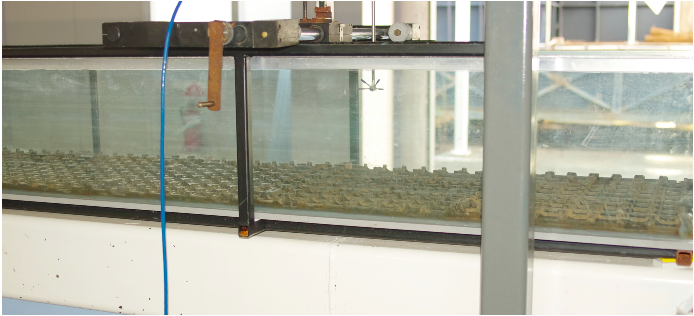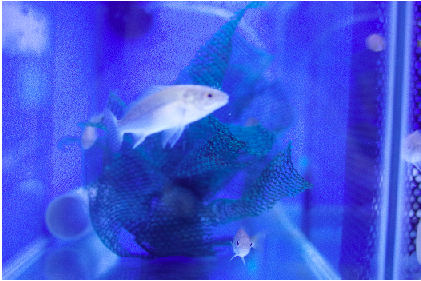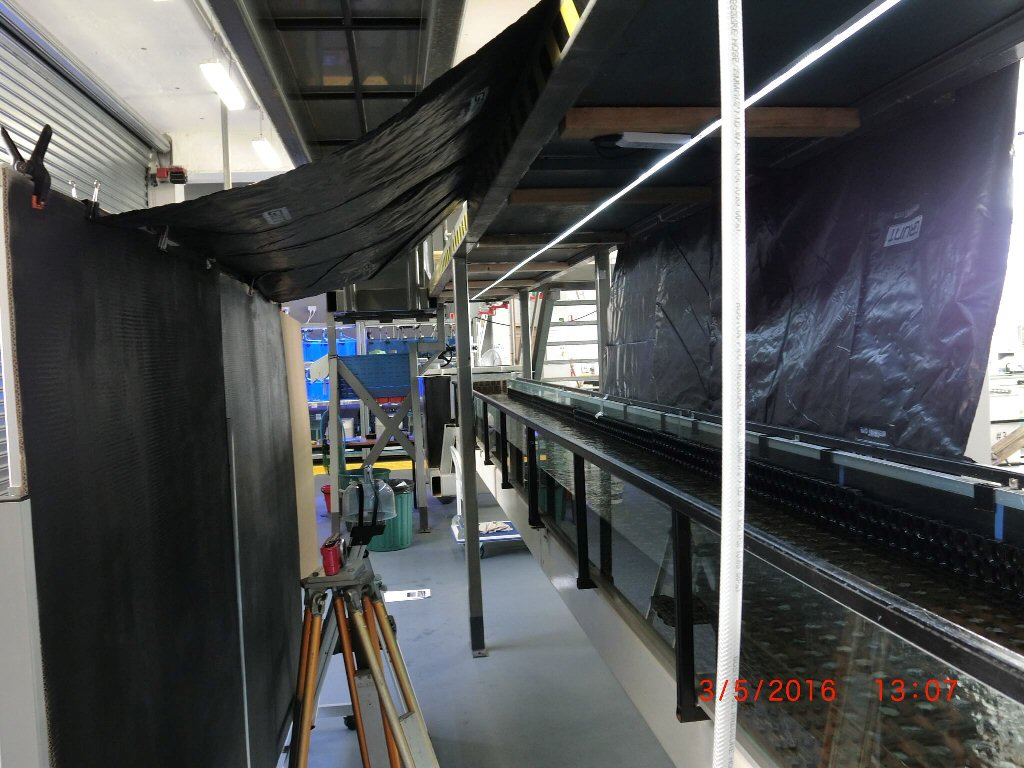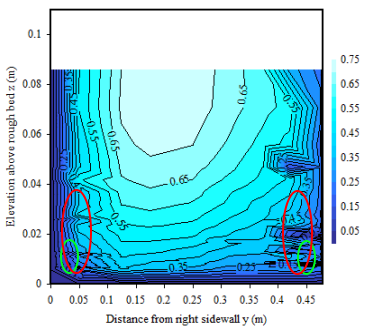Fish passage in culverts: hydrodynamic investigation
Mentor:
- Hubert Chanson
- Hang Wang
Project Team:
- Ramith Fernando
- Amelia Tatham
- Joseph Dowling
Project Brief
 Unimpeded waterway connectivity is a requirement for all freshwater fish. Barriers to fish movement can lead to population fragmentation and decline even in non‐migratory species. While the impacts of large dams on fish populations are well acknowledged, smaller‐scale instream structures like waterway crossings, culverts and weirs have until recently been overlooked despite having as great or greater impact on fish populations. Common issues hindering fish passage include excessive water velocity and turbulence, shallow flow depths, excessive vertical drop at the culvert and weir outlet (perched outlet), and blockage from debris accumulation at the structure inlet. In the new Bio-hydrodynamic research laboratory (Seddon complex), new hydraulic engineering experiments will be conducted, in collaboration with researchers from the UQ School of Biological Sciences. The project will aim to develop a better understanding of the effects of flow turbulence on fish migration and swimming performances.
Unimpeded waterway connectivity is a requirement for all freshwater fish. Barriers to fish movement can lead to population fragmentation and decline even in non‐migratory species. While the impacts of large dams on fish populations are well acknowledged, smaller‐scale instream structures like waterway crossings, culverts and weirs have until recently been overlooked despite having as great or greater impact on fish populations. Common issues hindering fish passage include excessive water velocity and turbulence, shallow flow depths, excessive vertical drop at the culvert and weir outlet (perched outlet), and blockage from debris accumulation at the structure inlet. In the new Bio-hydrodynamic research laboratory (Seddon complex), new hydraulic engineering experiments will be conducted, in collaboration with researchers from the UQ School of Biological Sciences. The project will aim to develop a better understanding of the effects of flow turbulence on fish migration and swimming performances.
Between December 2015 and June 2016, two group of Icarus students participated to the qualification of new facilities with several fish-friendly flumes, under the expert supervision of Prof. Hubert Chanson and Dr Hang Wang, as well as testing the fish kinematics under different boundary roughness. Earlier, a CIVL4560 project student test in the AEB Hydraulics laboratory (CHANSON and UYS 2016).
Activity
 In this project, the triangular baffle design proposed by CHANSON and UYS (2016) will be systematically tested in the Seddon Bio-Hydraulics Laboratory. The focus of the 2016/2 research campaign will be on how turbulence generated by triangular baffles may facilitate upstream fish migration in near-full-size culvert channels. The work will be conducted in the Bio-hydrodynamic hydraulic research laboratory (Seddon complex). The student(s) will conduct some research experiments under academic supervision in a world-known research laboratory. They/he/she will gain skills in data collection and data processing, together with some critical analysis of the results. Student(s) may also be asked to produce a report or oral presentation at the end of the project.
In this project, the triangular baffle design proposed by CHANSON and UYS (2016) will be systematically tested in the Seddon Bio-Hydraulics Laboratory. The focus of the 2016/2 research campaign will be on how turbulence generated by triangular baffles may facilitate upstream fish migration in near-full-size culvert channels. The work will be conducted in the Bio-hydrodynamic hydraulic research laboratory (Seddon complex). The student(s) will conduct some research experiments under academic supervision in a world-known research laboratory. They/he/she will gain skills in data collection and data processing, together with some critical analysis of the results. Student(s) may also be asked to produce a report or oral presentation at the end of the project.
- Each student will be expected to volunteer at least one and half day per week (preferably 2 days per week), and maximum 2.5 days per week, for the whole semester.
- Maximum 4-6 group size.
- Dates: 25 July - 28 October 2016 - An early commitment (before end of June) is required to obtain the ethical permits prior to the start of semester 2 (hopefully).
Project Report
Culverts are flow control mechanisms used to control flood waters. Primary design standards are dictated based on headwater and tailwater depth, inlet or outlet control, freeboard, erosion, siltation, fan curvature, length and energy loss (CONCRETE PIPE ASSOCIATION OF AUSTRALIASIA, 2012). With the occurrence of a flood event, marine wildlife are likely to be swept up from catchments, and in turn driven through developed regions.
In Australia no design procedures have been implemented to aid in fish passage through the developed region. This is an international concern and other countries have performed investigations to alter design protocol based on their fish species. These cannot be used in Australia due to the variation in native fish species attributes.
‘Fishcarus’ was a research investigation whose main goal was to modify current culvert design protocol to allow safer passage of native Australian fish through culverts. The primary investigation was into the effect of turbulence on fish trajectory, energy and performance with the introduction of surface roughness to the prototype design. Prior experimentation had been conducted over the summer at the hydrodynamic labs in the Seddon Complex, which was mainly comprised of flumes of different lengths and rubber mat configurations to develop a ‘fish bridge'.

These flumes where then used in testing fish performance using video tracking and relevant analysis. The flume configuration used to test the effect of turbulence was a rubber mat floor and one rubber mat sidewall. Working with researchers from the school of biology, juvenile Silver Perch were selected and testing was done for a total of 23 fish using three cameras at 240 frames per second. Analysis of the data was processed through tracker, and velocity and acceleration data was formulated.
At project completion our findings showed the relationship between use of turbulence through surface roughness and fish movement were not trivial. We discovered that fish would take preference to swimming in areas of high turbulence to maintain energy. This was especially true for the smaller fish, with a preference being observed more than 80% of the time. It is expected that at larger scales in real life scenarios, a preference to the lower velocity rough corner would be more frequently observed in fish of all sizes. The contour plot to the right provides a visual explanation of why smaller fish would have a greater preference for the rough corners than the larger fish – smaller fish experience the reduced flow velocity to a greater extent because of their smaller bodies.
Two main swimming patterns were observed: a resting pattern in which the fish would conserve or recover energy by swimming in one spot, and a burst pattern where the fish swam downstream. Often a fish would swim in a combination of these two patterns. Tracker revealed that fish in the resting pattern had a mean velocity of 0m/s ranging between -0.1 to 0.1 m/s, while the fish navigating upstream had mean burst velocities of 0.2 to 1 m/s, and a maximum of around 1.5 m/s.
Winter research used different roughness matting configurations to deliver varying degrees of turbulence, and future experimentation will revolve around the use of triangular baffles instead of rubber mats to provide a place for the fish to hide.


